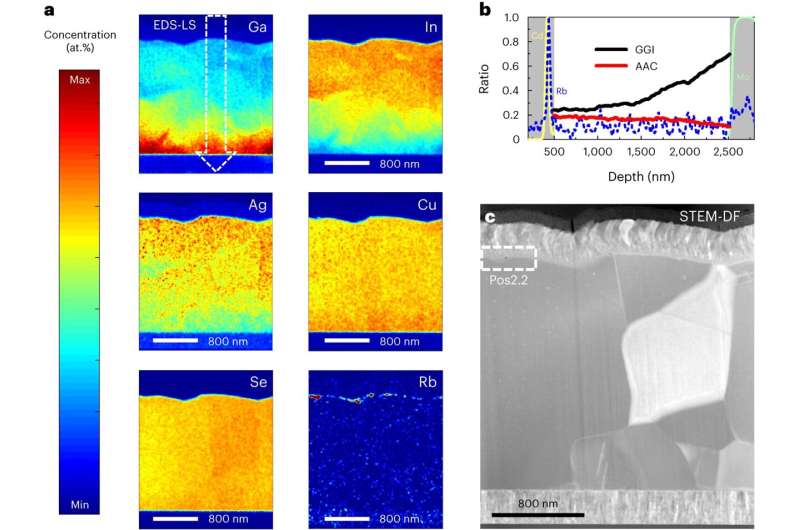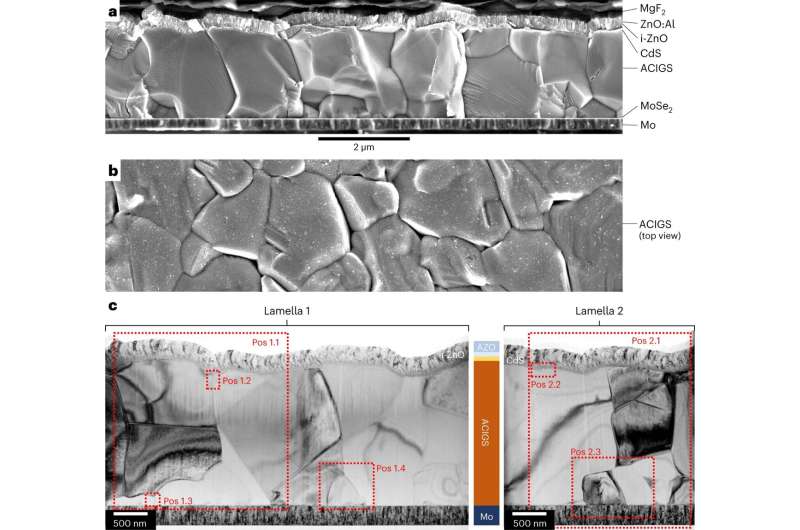March 2, 2024 feature
This article has been reviewed according to Science X's editorial process and policies. Editors have highlighted the following attributes while ensuring the content's credibility:
fact-checked
peer-reviewed publication
trusted source
proofread
A strategy to further boost the efficiency of copper indium gallium selenide solar cells

Until recently, chalcopyrite-based solar cells have achieved a maximum energy conversion efficiency of 23.35%, as reported in 2019 by Solar Frontier, a former Solar Energy company based in Japan. Further boosting this efficiency, however, has so far proved challenging.
Researchers at Uppsala University and at the First Solar European Technology Center AB (former Evolar AB) in Sweden recently attained a higher efficiency of 23.64% in chalcopyrite-based solar cells. This efficiency, reported in Nature Energy, was achieved using two primary techniques, namely high-concentration silver alloying and steep back-contact gallium grading.
"A primary objective of our study was to increase the efficiency of CIGS-based thin-film solar cells to ultimately lower the price per Watt-peak of corresponding large-scale modules," Jan Keller, first author of the paper, told Phys.org. "Our work makes use of the findings from many research groups around the world, obtained during the last decades."
One previous research effort that inspired this paper was the successful silver alloying with copper indium gallium selenide, first demonstrated by a research group in Japan about two decades ago. In addition, the researchers drew inspiration from research dating back to 10 years ago, which demonstrated the beneficial effects of implementing heavy alkali species into absorber materials.
"Besides building on about 40 years of international research on chalcopyrite solar cells, we combined four different approaches to improve the performance," Keller explained. "Specifically, we added a relatively high concentration of silver to the absorber, implemented a 'hockey stick'-like Gallium depth profile, tailored an RbF post-deposition treatment to the absorber composition, and subjected the absorber to extended illumination."
Combining these design and fabrication strategies, Keller and his colleagues could improve the microstructure of CIGS, reducing the density of defects and mitigating band gap fluctuations. In addition, they could passivate the surface of the absorber in their solar cell and increase the doping density.

In initial tests, their record CIGS solar cell achieved a high external radiative efficiency of 1.6%, resulting in a relatively low open-circuit voltage deficit. Notably, the device attained the highest efficiency reported in CIGS-based solar cells to date and its performance was externally certified by the independent institute Fraunhofer ISE (Germany).
"We were able to increase the previous record efficiency of CIGS-based solar cells from 23.35% (Solar Frontier, 2019, Japan) to 23.64% (externally certified), which is a substantial improvement," Keller said. "For the external certification a shadow mask (A=0.9 cm2) had to be used. Without the shadow mask, we even measured an efficiency of 23.75% in our labs (A=1.03 cm2)."
The recent work by this team of researchers introduces a promising production process for achieving higher efficiencies in chalcopyrite-based solar cells. These findings could serve as the basis for the further advancement of these solar cells, potentially contributing to their large-scale deployment.
In their paper, Keller and his colleagues outline a set of possible strategies to boost the performance of chalcopyrite-based solar cells, with the goal of reaching beyond a 25% efficiency. The most straightforward of these strategies entails mitigating parasitic absorption losses, which can be achieved in various ways.
"Ultimately, the defect density of the absorber bulk needs to be reduced. While CIGS-PV is more stable than current record-efficient perovskite devices, it is suffering from significantly higher non-radiative recombination losses. Thus, future research will concentrate on sandwiching an even better chalcopyrite film between even more transparent electrodes," Keller added.
"A recent study by EMPA (Switzerland) demonstrated a high potential for bifacial applications, which requires exchanging the Mo back contact by a transparent conductive oxide layer."
More information: Jan Keller et al, High-concentration silver alloying and steep back-contact gallium grading enabling copper indium gallium selenide solar cell with 23.6% efficiency, Nature Energy (2024). DOI: 10.1038/s41560-024-01472-3
Journal information: Nature Energy
© 2024 Science X Network





















